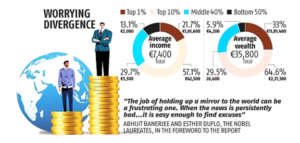Happy, Yes. Hype, No.
Relevance:
- GS 3: Indian Economy and Issues Relating to Planning, Mobilization of Resources.
- Tags: #GDP #RichPoorDivide #GS3 #IndianExpressEditorialAnalysis #G20.
Why in the News?
As India hosts the G-20 Summit amid growing anticipation, it’s crucial to control expectations. This routine event should prompt introspection about India’s challenges and priorities.
The growth of Multilateral Bodies
- Every year since 1999, the G-20 has had regular meetings. In 2008 (after the global financial crisis), Washington hosted the first summit of Heads of state.
- The leaders have numerous opportunities to meet under various auspices banners between two G-20 summits, including the UN, G-7, WEF, IPCC, SCO, BRICS, QUAD, AUKUS, ASEAN, UNCTAD, and others.
- The joke goes that if you choose any four or five letters from the English alphabet, they probably stand for a brand-new multilateral organization.
Modesty is Becoming
- Rotations are used to choose the G-20 Chair. In 2003 and 2023, India will serve as Chair. The 2043 Chair will once again be held by India.
India has good cause to be modest
- India is the G-20 member country with the lowest per capita income ($2,085), the most poor people (230 million), and the 107th-highest ranking (out of 123) in the Global Hunger Index.
- That is not meant to undervalue India’s progress since 1991. Only a handful of nations, on average every ten years, have doubled their GDP in constant prices:
| Year | GDP(Constant Price) |
| 1991-92
2003-04 2013-14 |
Rs 25 lakh crore
Rs 50 lakh crore Rs 100 lakh crore
|
GDP won’t double
The GDP won’t double by 2023–2024 despite a strong start in 2014–15, which is a missed opportunity. The primary cause of this is-
- This is due to the lower average growth rate of 5.7% during the 9 years of the NDA government compared to the 7.5% during the 10 years of the UPA government.
- Despite lifting 415 million people out of poverty since 2004, 230 million still remain impoverished, even though the poverty threshold is relatively low, with urban areas requiring a monthly consumption of Rs 1,286 and rural areas Rs 1,089.
- Despite impressive scientific achievements like landing a probe on the moon, educational disparities persist, with 30% of Class VIII students unable to read Class II texts, and 55% struggling with basic multiplication and division.
- This complex scenario illustrates the mixed outcomes of India’s development efforts.
Elevating Our Global Standing: A Call for Reform
To enhance our international reputation and influence, we must
- Strengthen our democratic values, embracing liberalism, pluralism, and religious tolerance.
- Foster robust discussions and dissent in Parliament and State legislatures, ensuring thorough scrutiny and debate in policymaking.
- Uphold the rule of law universally, eradicating Hasty or summary justice, lynching, and hate crimes.
- Prioritize being market-friendly over favoring business interests, promoting openness to investment, technology, and competition.
- Ensure true independence and non-partisanship of vital institutions like Courts, Election Commission of India, C&AG, Human Rights Commission, and Information Commission.
- Prevent investigative agencies from assuming unchecked authority and intimidating individuals, institutions, and political parties.
Global Awareness of Our Shortcomings
- We cannot fool ourselves into believing that only Indian citizens see our flaws.
- The international society notices our own shortcomings just as we see dictatorial regimes, rigged elections, widespread racism, gender oppression, denials of political and human rights, tribal conflicts, and corporate monopolies occur all over the world.
Concerns in the Economic Landscape
- The G-20 expresses serious worries about the state of the world economy at the moment.
- Economists generally agree that economic expansion benefits society as a whole by having a favorable influence on people’s actions, public discourse, and behavior.
- An illustration of the impact of economic prosperity is shown in the change in language usage, such as the decline in the use of “Madras Tamil,” which was common in Chennai throughout the 1960s and 1970s.
The Path to Prosperity: Factors Behind Wealthy Nations
Four main characteristics, which are driving prosperity and development, what determine a nation’s wealth and its rate of economic growth are
- Strong infrastructure spending, significant funding for healthcare and education, and active involvement in international trade.
- India, however, is lacking in a number of areas.
- We do invest in infrastructure, but our efforts are still insufficient.
- Additionally, our spending on healthcare and education both remain significantly low at 1.4 percent of GDP and 3% of GDP, respectively.
- Due to the implementation of policies like higher customs tariffs, export levies, import limitations, country-specific duties, and the slowly developing free trade agreements, we have deteriorated despite historical trade improvements.
Rising Inequality
- The rise in inequality is the other troubling phenomenon.
- It is hailed as an increase in the income of all 140 billion Indians when the average income of the 7 crore people who file income tax returns—of which more than half do not—increases.
- How could all Indians have become wealthier when the unemployment rate is 8.5% and the jobless rate for those aged 15 to 24 is 24%?
- How could all Indians be wealthy if the bottom 50% of the population owns only 3% of the country’s wealth and earns only 13% of the income?
As the leaders of the world’s top 20 economies converge to scrutinize India and its economy, I hope we introspect more deeply into our own situation.
Source: Indian Express.
Mains Question
Analyze the factors influencing economic growth in India and the missed opportunities for doubling its GDP by 2023-24. How can India overcome these challenges and achieve sustainable economic development.




